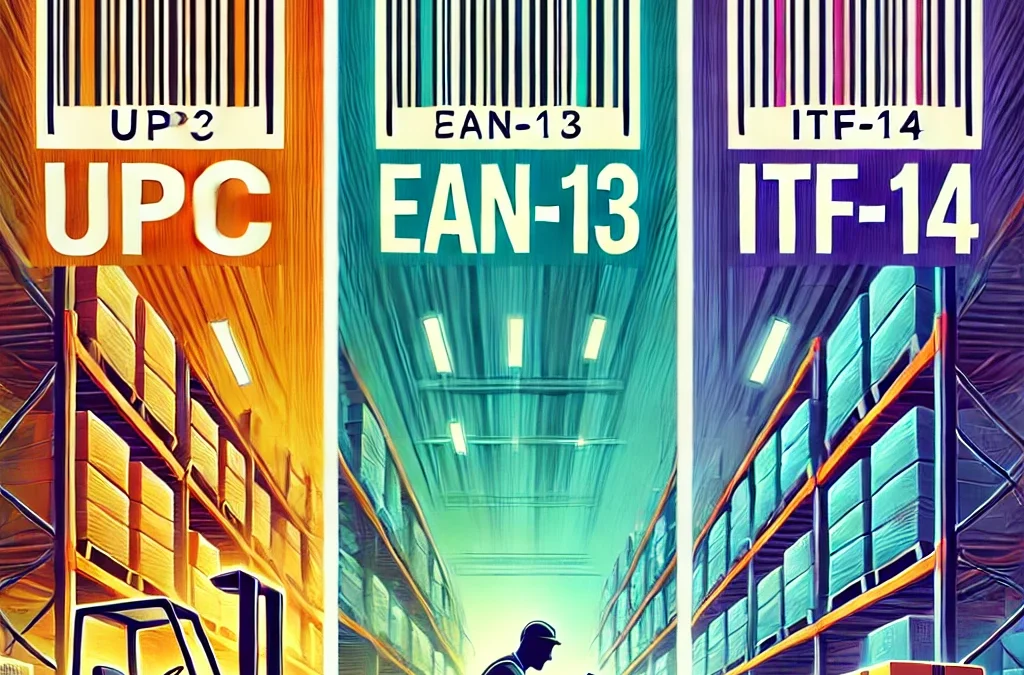Mastering Barcode Types for Warehouse Efficiency: UPC, EAN-13, and ITF-14 Explained
Understanding UPC, EAN-13, and ITF-14 Barcodes in Warehouse Operations
Introduction
In the fast-paced world of warehouse operations, barcodes are essential for inventory management, tracking, and order fulfillment. Barcodes like UPC, EAN-13, and ITF-14 streamline operations by encoding information into a scannable format, allowing warehouse staff to quickly and accurately track goods through every stage of the supply chain. In this guide, we’ll explore each of these barcode types, how they are used in warehouse settings, and their distinct differences.
The Basics of Barcodes in Warehousing
Barcodes in warehouses play a critical role in maintaining accuracy, efficiency, and speed. By scanning barcodes, warehouse operators can retrieve information about a product’s identity, location, stock levels, and order status instantly. Here’s a deeper dive into the three most widely used barcode types in warehouses: UPC, EAN-13, and ITF-14.
UPC (Universal Product Code)
The Universal Product Code (UPC) is one of the most recognizable barcodes, particularly in North America. Originally developed to streamline grocery store operations, UPC has since become a universal staple for retail and warehousing.
Structure of a UPC Barcode
- Format: 12 digits.
- Sections: The first six digits represent the manufacturer, the following five digits represent the product, and the final digit is a check digit, ensuring the code’s validity.
- Symbology: A linear, one-dimensional (1D) barcode.
Uses of UPC in Warehouses
UPCs are mainly used for retail-ready products. Their primary role is in identifying products at the item level. In warehouses, UPC barcodes assist with:
- Inventory Tracking: Scanning UPCs when products enter or leave storage helps update stock records in real-time.
- Order Picking: UPCs aid in product identification during the picking process, ensuring accuracy in customer orders.
- Replenishment and Stock Audits: Quick, accurate scans help warehouse staff conduct inventory checks and locate products faster.
EAN-13 (European Article Number)
EAN-13 is another popular barcode used internationally. While similar to UPC, EAN-13 includes additional digits to accommodate a wider range of product codes, making it ideal for use across global markets.
Structure of an EAN-13 Barcode
- Format: 13 digits.
- Sections: The first three digits represent the country code, followed by the manufacturer code, product code, and a check digit.
- Symbology: Also a linear, one-dimensional barcode.
ITF-14 (Interleaved Two of Five)
The ITF-14 barcode, also known as the Shipping Container Code (SCC-14), is used specifically for larger quantities like cases, cartons, or pallets. ITF-14 is crucial for warehouses that need a barcode type capable of handling high-stress environments like bulk shipments.
Structure of an ITF-14 Barcode
- Format: 14 digits.
- Sections: This includes a packaging level indicator, GS1 company prefix, item reference, and a check digit.
- Symbology: ITF-14 uses a two-dimensional format, offering greater resilience in warehousing conditions where barcodes may be exposed to wear.
Key Differences Between UPC, EAN-13, and ITF-14
| Feature | UPC | EAN-13 | ITF-14 |
|---|---|---|---|
| Digit Count | 12 digits | 13 digits | 14 digits |
| Primary Use | Individual retail items | International retail items | Bulk cases and pallets |
| Common Regions | North America | Global | Worldwide |
| Environment | Retail, light warehousing | Global retail, warehousing | Warehousing, shipping, logistics |
Barcodes like UPC, EAN-13, and ITF-14 are essential tools for warehouse management, offering unique benefits and ensuring operational efficiency. Whether you’re tracking individual retail items or bulk shipments, understanding the differences and applications of these barcodes is critical for improving accuracy, productivity, and customer satisfaction. By implementing the appropriate barcode types and practices, your warehouse can operate at peak efficiency, adapting seamlessly to the demands of modern supply chains.

